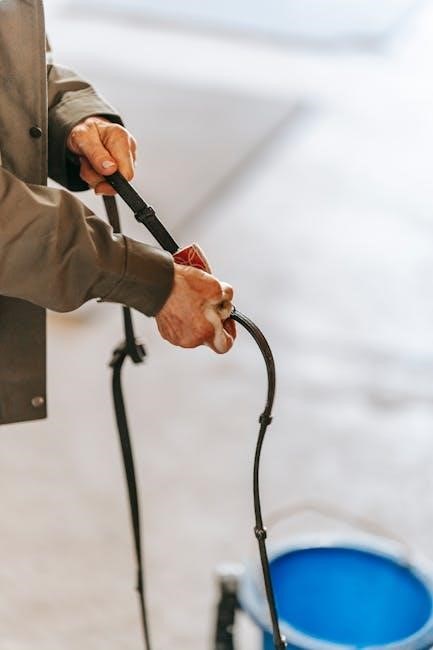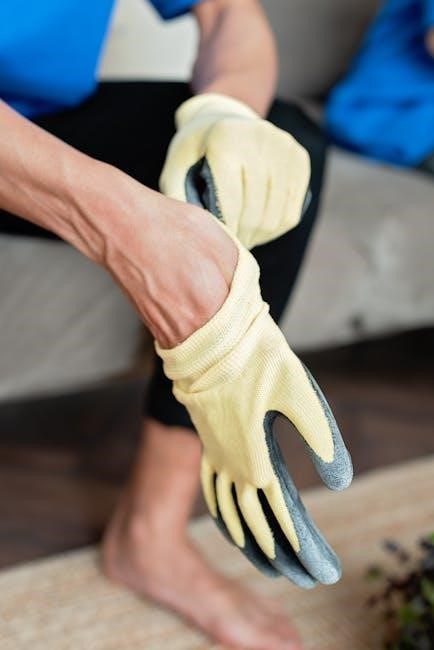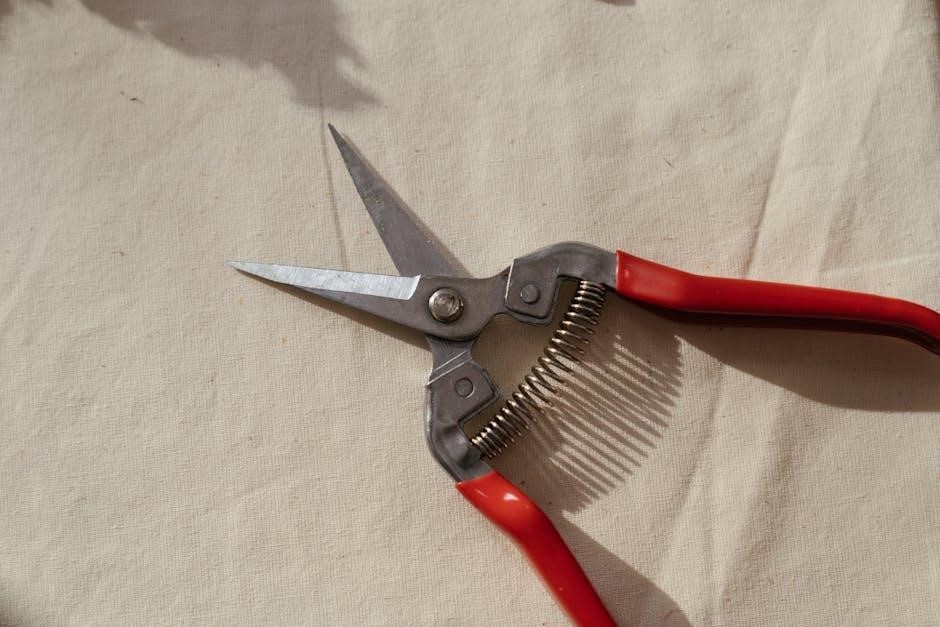Manual handling equipment is essential in care settings to enhance safety, efficiency, and patient well-being․ It reduces physical strain on caregivers and promotes patient independence․

Definition and Purpose of Manual Handling in Care
Manual handling in care refers to the process of moving, lifting, or repositioning patients or residents to ensure their safety and comfort․ It involves the use of equipment and techniques to minimize physical strain on caregivers while maintaining patient dignity․ The primary purpose is to prevent injuries to both caregivers and patients, enhance mobility, and promote independence․ Effective manual handling ensures safe transfers, reduces the risk of falls, and improves overall care quality․ Proper training and equipment, such as hoists and slings, are crucial for successful implementation; This approach is essential in healthcare and social care settings to create a safer and more efficient environment․
Importance of Manual Handling Equipment in Healthcare
Manual handling equipment is vital in healthcare to prevent injuries and ensure patient safety․ It reduces the physical strain on caregivers, minimizing the risk of musculoskeletal disorders․ By using tools like hoists, slings, and transfer belts, healthcare professionals can safely move patients, reducing the likelihood of falls and injuries․ This equipment also enhances patient dignity and comfort, making care delivery more efficient․ Properly utilizing manual handling equipment not only protects staff but also improves the overall quality of care provided․ It is a crucial component in maintaining a safe and effective healthcare environment, benefiting both patients and caregivers alike․ Regular training and equipment maintenance are essential to maximize its benefits․
Types of Manual Handling Equipment
Manual handling equipment includes various tools designed to assist in moving, transferring, and supporting patients safely․ Examples range from sliding sheets to advanced hoisting systems, each serving a specific purpose to enhance care efficiency and prevent injuries․

Sliding Sheets
Sliding sheets are essential tools in care environments, designed to ease patient transfers and repositioning by minimizing friction․ Constructed from durable, washable materials, they are used in beds or on floors to assist with movements․ This reduces the physical strain on caregivers and enhances patient comfort․ Regular use of sliding sheets can significantly decrease injury risks for both patients and staff by eliminating the need for manual lifting․ Proper training is crucial for their effective use, ensuring safety and dignity in care․ They are a fundamental component of safe handling practices, promoting efficiency and reducing the risk of accidents during patient transfers․
Transfer Belts
Transfer belts are key manual handling tools in care settings, offering stability and support during patient transfers․ These adjustable belts are securely fastened around a patient’s waist, providing caregivers with a firm grip to assist with standing or moving․ They are particularly useful for patients with limited mobility, reducing the risk of slips and falls․ Transfer belts promote patient safety and caregiver confidence, enabling smoother transitions between surfaces․ Proper training in their use is essential to ensure both patient and staff safety․ Regular inspections of the belts are recommended to maintain their effectiveness and reliability in care environments․ They are a simple yet effective solution for safe transfers․

Transfer Boards
Transfer boards are lightweight, versatile tools used to assist patients with limited mobility in moving between surfaces․ Made of durable materials, they provide a smooth, stable surface for sliding or transferring․ These boards are ideal for transitions from beds to wheelchairs or commodes․ They reduce friction, minimizing strain on both patients and caregivers․ Proper positioning and support are crucial for safe use․ Transfer boards are easy to clean and maintain, making them practical for daily care routines․ They are an essential piece of equipment for promoting patient independence while ensuring safety and comfort during transfers․ Regular inspections ensure they remain effective and reliable in care settings․
Mobile Hoists
Mobile hoists are versatile and portable devices designed to lift and transfer patients safely․ They are battery-powered, allowing easy movement between rooms․ Equipped with adjustable spreader bars and slings, they accommodate various patient needs․ Mobile hoists are ideal for use in homes, hospitals, or care facilities, providing flexibility in caregiving․ Regular maintenance ensures optimal performance and safety․ They reduce physical strain on caregivers and enhance patient comfort during transfers․ Proper training is essential for safe operation․ Mobile hoists are a cornerstone of modern care, enabling efficient and dignified patient handling while minimizing the risk of injury to both patients and caregivers․ They are indispensable in promoting independence and well-being․

Fixed Wall Hoists
Fixed wall hoists are permanently installed in specific locations, such as bathrooms or bedrooms, offering stability and reliability for patient transfers․ They are typically electric or manual, with adjustable features to accommodate different patient needs․ These hoists are ideal for long-term care settings due to their durability and constant availability․ They minimize the risk of accidents and reduce caregiver strain by providing a secure lifting mechanism․ Regular maintenance is crucial to ensure safety and functionality․ Fixed wall hoists are a practical solution for facilities requiring consistent, dependable lifting assistance, enhancing both patient care and staff efficiency while maintaining a safe environment․
Slings
Slings are essential components of hoisting systems, designed to support patients during transfers․ They come in various styles, including universal, hammock, and standing slings, catering to different patient needs and mobility levels․ Made from durable, breathable materials, slings ensure comfort and safety․ Proper fitting is crucial to prevent discomfort or injury, and they must be used in conjunction with appropriate hoists․ Slings are single-client use or reusable, depending on the type, and are widely used in care settings for bathing, dressing, or repositioning․ Regular inspection and maintenance are vital to ensure their integrity and performance, making them a reliable tool in manual handling care routines․
Wheelchairs
Wheelchairs are versatile tools in care settings, enabling residents to move independently or with assistance․ They come in manual or powered versions, with adjustable features like seats, armrests, and footrests to suit individual needs․ Wheelchairs are commonly used for transporting patients, promoting mobility, and enhancing quality of life; They are particularly useful for residents with limited walking abilities, providing both comfort and support․ Proper selection and maintenance are crucial to ensure safety and functionality․ Caregivers should receive training on wheelchair use to prevent accidents and injuries, making wheelchairs an indispensable piece of manual handling equipment in care environments․ Regular inspections ensure they remain safe and reliable for daily use․
Standing and Pivoting Aids
Standing and pivoting aids are essential tools designed to assist caregivers in safely moving and repositioning patients․ These devices, such as standaids or transfer aids, provide stability and support, enabling patients to stand or pivot with minimal effort․ They are particularly useful for short transfers, such as moving from a bed to a chair, and help reduce physical strain on both caregivers and patients․ Proper training is crucial to ensure safe and effective use, minimizing the risk of accidents․ By promoting patient independence and reducing manual lifting, standing and pivoting aids play a vital role in enhancing care quality and safety in healthcare settings․ Regular maintenance ensures reliability and longevity of these aids․
Shower and Bath Equipment

Shower and bath equipment are crucial for safely assisting patients with personal hygiene․ These include bath hoists, shower chairs, and non-slip mats, designed to prevent falls and injuries․ Bath hoists allow caregivers to transfer patients into and out of bathtubs with minimal effort, while shower chairs provide stability during bathing․ Such equipment not only enhances patient safety but also promotes dignity and independence․ Proper training on their use is essential to ensure effective and safe hygiene care․ Regular maintenance of these aids is vital to guarantee their reliability and longevity in care settings․ They play a key role in maintaining the overall well-being of patients in healthcare environments․
Emergency Equipment
Emergency equipment is vital for responding to sudden incidents in care settings, such as falls or medical emergencies․ This includes hoists designed to lift patients from the floor, stand aids, and emergency slings․ These tools enable caregivers to act quickly and safely, minimizing the risk of further injury․ Proper training in using this equipment is essential to ensure effective response․ Regular maintenance and availability of emergency equipment are critical to providing timely assistance․ Their role is to ensure patient safety and comfort during unexpected situations, making them indispensable in healthcare environments․ They help prevent complications and support immediate care needs effectively․

Best Practices for Using Manual Handling Equipment
Proper training, regular equipment checks, and adherence to care plans are crucial for safe and effective use of manual handling equipment in care settings․
Assessment and Planning Before Equipment Use
Before using manual handling equipment, a thorough assessment of the patient’s needs and abilities is essential․ This involves evaluating their mobility, weight, and any medical conditions that may impact handling․ Caregivers should also consider the environment, ensuring spaces are clear of obstacles to facilitate smooth transfers․ The care plan should outline specific goals and the most suitable equipment for each task․ Manufacturers’ instructions must be reviewed to ensure proper use․ Additionally, the patient’s preferences and comfort should be taken into account to promote cooperation and reduce anxiety․ A well-planned approach minimizes risks and enhances safety for both the patient and caregiver․
Training and Competency in Equipment Use
Proper training is crucial for the safe and effective use of manual handling equipment․ Caregivers must receive comprehensive instruction, including hands-on practice, to ensure they understand how to operate each device correctly․ Training should cover equipment specifics, manufacturer guidelines, and patient-centered techniques to minimize risks․ Regular updates and competency assessments are essential to maintain skill levels and adapt to new technologies or procedures․ Inadequate training can lead to injuries, equipment damage, or non-compliance with safety standards․ Competent use of equipment not only protects patients but also reduces the physical and emotional strain on caregivers, fostering a safer care environment for all․
Regular Maintenance of Equipment
Regular maintenance is vital to ensure manual handling equipment remains safe and functional․ Caregivers should perform routine inspections, checking for wear, tear, and damage․ This includes examining slings, hoist components, and other parts for signs of deterioration․ Manufacturer guidelines should be followed for maintenance schedules and procedures․ Faulty equipment must be taken out of service immediately to prevent accidents․ Additionally, a record-keeping system can track maintenance activities, ensuring compliance with safety standards and regulations․ Proper upkeep not only extends the equipment’s lifespan but also protects both patients and staff from potential hazards, maintaining a reliable and efficient care environment․

Common Risks and Challenges
Common risks include equipment failure, improper use, and patient resistance․ Addressing these challenges is crucial for safety and effective care delivery․
Identifying Hazards in Manual Handling
Identifying hazards in manual handling is crucial to prevent injuries and ensure safe care practices․ Common hazards include equipment malfunction, improper use of devices, and patient resistance․ Environmental factors such as cluttered spaces or uneven surfaces can also pose risks․ Additionally, the physical condition of the patient, such as weight or mobility issues, can increase the likelihood of accidents․ Caregivers should conduct thorough risk assessments before using any equipment, ensuring that both the patient and staff are protected․ Regular training and equipment maintenance can significantly reduce these hazards, promoting a safer caregiving environment for all involved․
Patient Resistance and Cooperation
Patient resistance and cooperation play a significant role in manual handling safety․ Resistance can stem from fear, discomfort, or lack of understanding, increasing the risk of accidents․ Ensuring clear communication and building trust helps gain patient cooperation․ Caregivers should explain procedures and involve patients in the process to reduce anxiety․ Using appropriate equipment, such as transfer belts or slings, can also enhance patient confidence․ Training caregivers in effective communication and empathy is essential to address resistance and foster a collaborative environment․ Positive interactions contribute to safer handling practices and improved patient outcomes in care settings․ Regular updates on care plans can further align patient expectations with safe handling procedures․

Future Trends in Manual Handling Equipment
Future trends emphasize ergonomic designs, smart technologies, and advanced materials to enhance safety and efficiency in care settings, reducing physical strain and improving patient care outcomes․
Advancements in ergonomic design focus on creating manual handling equipment that aligns with the natural movement of caregivers, reducing physical strain and injury risks․ Modern equipment incorporates lightweight materials, adjustable features, and intuitive controls to enhance user experience․ For instance, electric lifting hoists and stand aids now feature ergonomic handles and balanced weight distribution, ensuring smoother transfers․ Additionally, slings and belts are designed with breathable, comfortable materials to improve patient comfort․ These innovations not only protect caregivers but also promote dignity and safety for patients during handling․ By prioritizing ergonomics, manufacturers are setting new standards for efficient and compassionate care delivery․Advancements in Ergonomic Design




